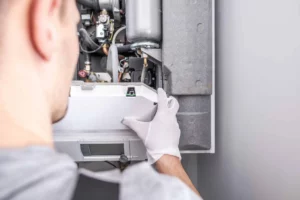Understanding Indoor Humidity Levels in Milwaukie, OR: What’s Ideal?
Maintaining proper indoor humidity levels is crucial for creating a comfortable and healthy living environment, especially in a place like Milwaukie, OR, where the weather can shift from damp, rainy winters to warm, dry summers. Humidity plays a significant role in how comfortable your home feels, affects your health, and even impacts the condition of your furniture and home structure. Too much humidity can lead to mold growth and discomfort, while too little can cause dry skin and respiratory issues.
Understanding what the ideal indoor humidity levels are and how to achieve them can make a big difference in your overall comfort. In this guide, we’ll explore the importance of maintaining optimal humidity, the ideal ranges, and practical tips for managing humidity levels in your home.
1. What Are Indoor Humidity Levels?
Indoor humidity refers to the amount of moisture in the air inside your home. It’s typically measured as relative humidity (RH), which is the percentage of moisture in the air compared to the maximum amount of moisture the air can hold at a given temperature. For example, 50% relative humidity means the air holds half the moisture it’s capable of holding at that temperature.
Humidity levels inside your home have a significant impact on comfort, health, and even the integrity of your home’s structure. High humidity can make the air feel sticky and warm, while low humidity can make it feel dry and cool. Striking the right balance is essential for maintaining a comfortable and healthy indoor environment.
Understanding the basics of indoor humidity can help you better manage it throughout the year, particularly in regions like Milwaukie, where outdoor weather conditions fluctuate. By keeping your indoor humidity within the ideal range, you can improve your home’s comfort and efficiency while protecting your health.

2. The Ideal Indoor Humidity Range
The ideal indoor humidity range for most homes is between 30% and 50%. Maintaining humidity within this range helps ensure a comfortable living environment, prevents moisture-related issues, and promotes better indoor air quality. Here’s why staying within this range is beneficial:
- Comfort: When humidity levels are balanced, your home feels more comfortable at a wider range of temperatures, allowing you to set your thermostat at an energy-saving level without sacrificing comfort.
- Health: Proper humidity levels help reduce allergens like dust mites and mold, which thrive in high humidity. Conversely, low humidity can dry out your respiratory tract and skin, increasing susceptibility to colds and respiratory discomfort.
- Home Preservation: Maintaining ideal humidity protects your home’s structure and furnishings. High humidity can lead to mold growth, wood warping, and paint peeling, while low humidity can cause wood to crack and floors to shrink.
Keeping your indoor humidity within the recommended range is a simple yet effective way to enhance comfort, protect your health, and preserve the condition of your home. If you’re struggling to maintain these levels, our heating service experts can help assess and improve your home’s humidity control.
3. Effects of High Indoor Humidity
High indoor humidity, typically above 50%, can create a host of problems that affect your comfort, health, and home. Excess moisture in the air makes your home feel warmer than it actually is, leading to discomfort and increased reliance on air conditioning, which in turn drives up energy costs. But the impacts of high humidity extend beyond just discomfort.
Here are some common issues caused by high indoor humidity:
- Mold and Mildew Growth: Excess moisture creates the perfect environment for mold and mildew, which can grow on walls, ceilings, and other surfaces. Not only does this damage your home, but it also poses serious health risks, including allergies and respiratory problems.
- Increased Allergens: High humidity encourages the proliferation of dust mites and other allergens, which can worsen asthma and allergy symptoms.
- Damage to Home and Belongings: Wood furniture, floors, and even musical instruments can warp or crack due to high humidity. Additionally, excess moisture can cause paint to peel and create musty odors that are hard to eliminate.
To combat high humidity, consider using a dehumidifier or enhancing your home’s ventilation. Regular heating maintenance can also help by ensuring your HVAC system is functioning efficiently and properly managing indoor moisture levels.
4. Effects of Low Indoor Humidity
Low indoor humidity, generally below 30%, can be just as problematic as high humidity. During the colder months, heating systems can dry out the air inside your home, leading to a range of issues that affect your health, comfort, and even your home’s integrity. Here are some common problems associated with low indoor humidity:
- Health Issues: Dry air can irritate your respiratory tract, worsen asthma and allergy symptoms, and lead to dry skin, chapped lips, and itchy eyes. It can also make you more susceptible to colds and flu, as dry conditions allow viruses to survive longer in the air.
- Increased Static Electricity: Low humidity increases static electricity, which can be a nuisance and even pose a risk to electronic devices.
- Damage to Wood and Furnishings: Just as high humidity can warp wood, low humidity can cause wood floors, furniture, and musical instruments to crack, shrink, or become brittle. This can lead to costly repairs or replacements.
- Uncomfortable Living Conditions: Low humidity can make the air feel colder, prompting you to increase the heat and, consequently, your energy bills.
To address low humidity, consider using a humidifier to add moisture back into the air. Whole-home humidifiers, integrated with your HVAC system, offer a convenient way to maintain ideal humidity levels throughout your home. For professional advice and installation, explore our heating installation services to find the best solution for your needs.

5. How to Manage Indoor Humidity Levels
Managing indoor humidity levels effectively is key to maintaining a comfortable and healthy home environment. Whether you’re dealing with high or low humidity, there are several strategies and tools you can use to keep humidity within the ideal range of 30-50%. Here are some practical tips for controlling indoor humidity:
- Use Humidifiers and Dehumidifiers: For homes with low humidity, humidifiers add moisture to the air, improving comfort and reducing the risk of dry air-related issues. For high humidity, dehumidifiers remove excess moisture, helping to prevent mold growth and other moisture-related problems.
- Improve Ventilation: Proper ventilation is crucial for managing humidity. Use exhaust fans in bathrooms, kitchens, and laundry rooms to vent moisture outside. Additionally, ensure your home is adequately ventilated, especially in areas prone to higher moisture levels, such as basements and attics.
- Seal Leaks and Insulate: Prevent outdoor air from affecting your indoor humidity by sealing leaks around windows, doors, and in your home’s insulation. Proper insulation can also help maintain consistent indoor temperatures, which in turn helps regulate humidity levels.
- Maintain Your HVAC System: Your HVAC system plays a crucial role in managing humidity. Regular heating maintenance and heating service can ensure your system is operating efficiently, with clean filters and properly functioning components that help control indoor moisture levels.
By taking these steps, you can keep your home’s humidity levels in check, enhancing comfort and protecting your health and property. For expert guidance on managing your home’s humidity, contact us at Ultimate Comfort to schedule a consultation.
6. Choosing the Right Humidity Solutions for Your Home
Finding the right humidity solutions for your home can make all the difference in achieving and maintaining the ideal indoor environment. Depending on your specific needs, there are various tools and technologies available to help you regulate humidity effectively and efficiently. Here are some options to consider:
- Whole-Home Humidifiers: Integrated directly into your HVAC system, whole-home humidifiers add moisture to the air as it circulates through your home. This solution is ideal for combating low humidity during the winter months and provides consistent comfort across all rooms.
- Whole-Home Dehumidifiers: If high humidity is a concern, a whole-home dehumidifier can be integrated into your HVAC system to remove excess moisture. This solution is particularly beneficial during Milwaukie’s damp seasons, helping to prevent mold growth and other moisture-related issues.
- Smart Thermostats with Humidity Control: Many modern smart thermostats come with built-in humidity sensors and controls, allowing you to monitor and adjust humidity levels from your smartphone. This provides convenient, real-time control over your home’s indoor environment.
- Professional Assessment and Installation: To ensure that your humidity solutions are tailored to your home’s unique needs, it’s best to consult with a professional. Our team at Ultimate Comfort can assess your current system, recommend the best options, and handle the installation of humidifiers, dehumidifiers, or other solutions. Explore our heating installation services for expert guidance.
Choosing the right humidity management solution not only improves comfort but also enhances the overall efficiency and health of your home. For personalized advice and professional installation, contact Ultimate Comfort to find the perfect fit for your home’s needs.

Conclusion: Keep Your Home Comfortable with Optimal Humidity Levels
Maintaining the ideal indoor humidity levels in your Milwaukie, OR home is essential for ensuring comfort, promoting good health, and protecting your property. By keeping humidity within the recommended range of 30-50%, you can prevent issues like mold growth, allergens, and damage to your home’s structure and furnishings. Understanding the effects of both high and low humidity and implementing effective solutions, such as whole-home humidifiers or dehumidifiers, can make a significant difference in your indoor environment.
At Ultimate Comfort, we are dedicated to helping you achieve the perfect balance of humidity in your home. Whether you need a professional assessment, maintenance, or installation of humidity control solutions, our expert team is here to assist. Don’t let fluctuating humidity levels compromise your comfort—contact us today to schedule a consultation and keep your home’s humidity in check all year round.

